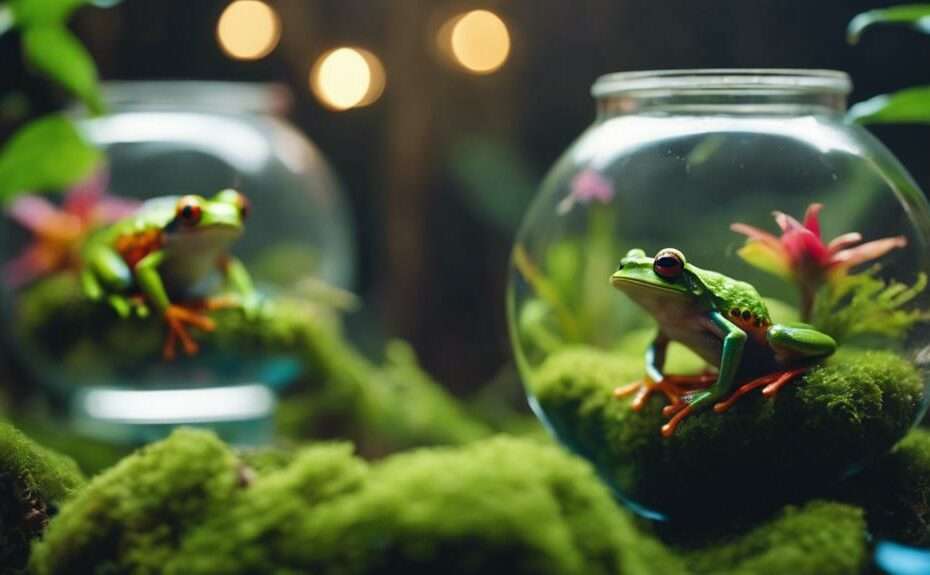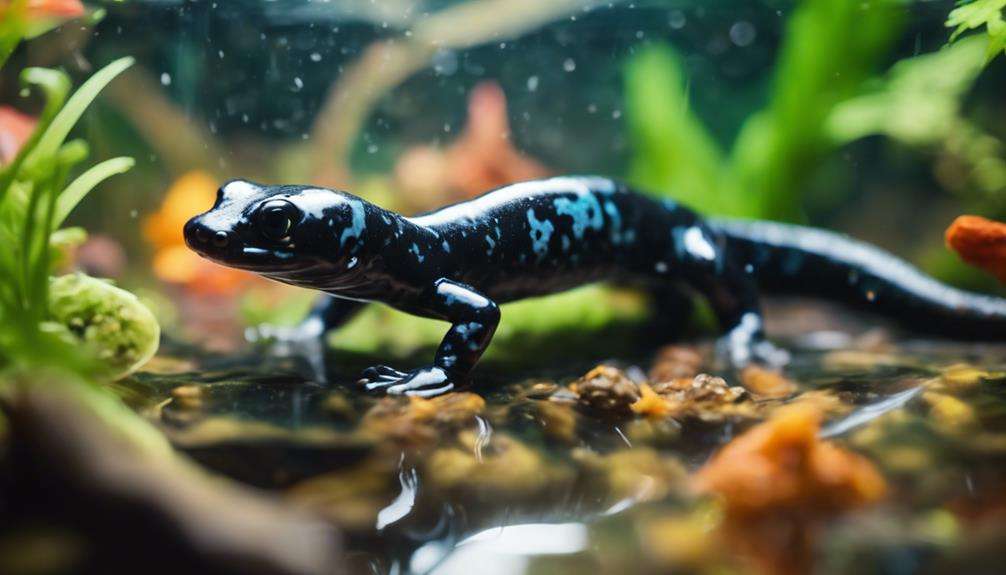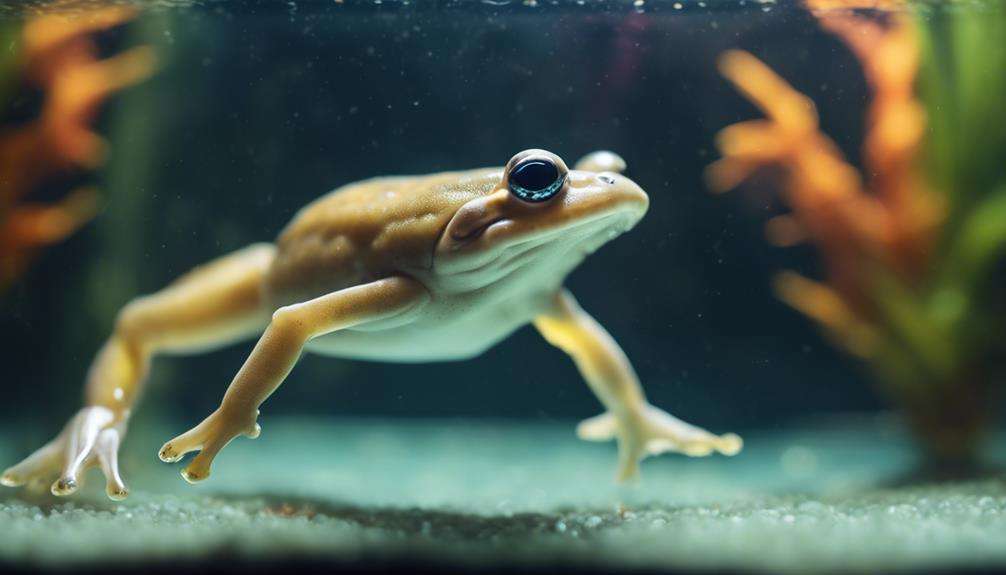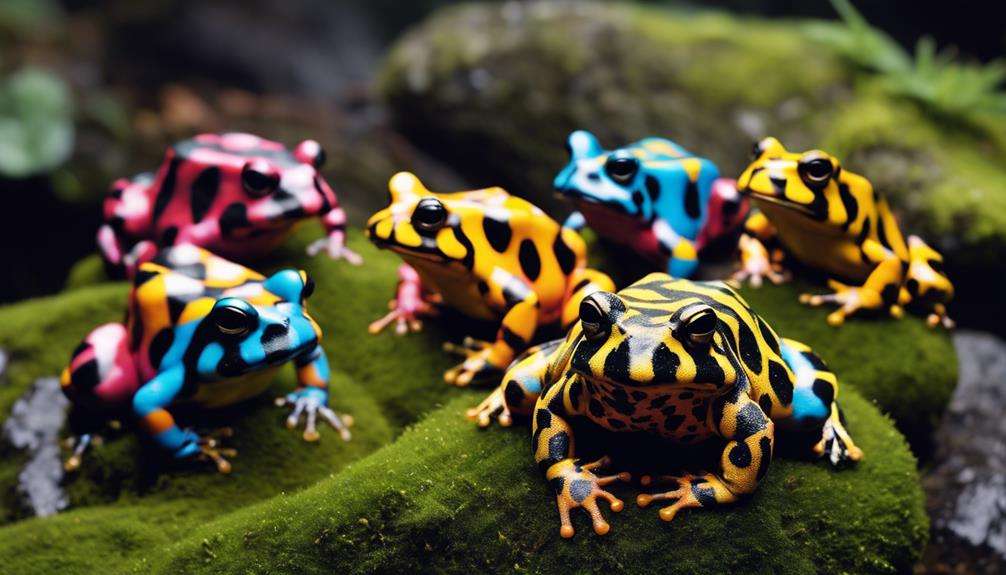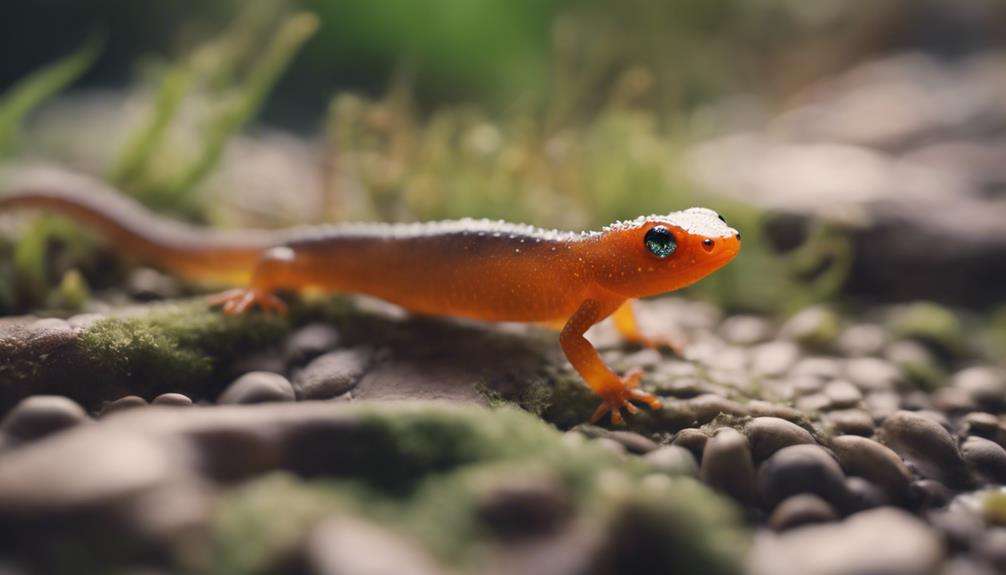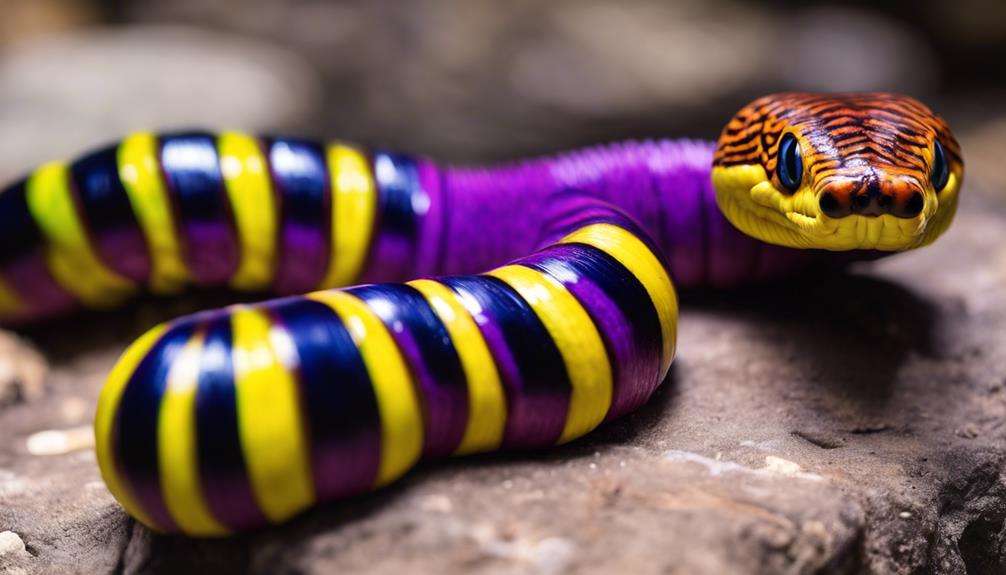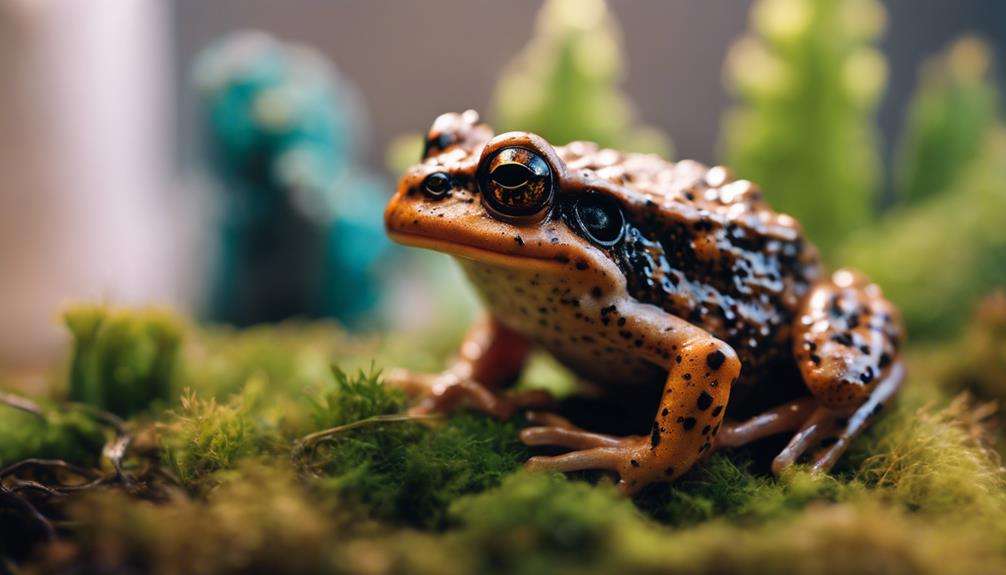If you're considering an easy-to-care-for pet, did you know that tree frogs can live up to 10+ years? These fascinating creatures are not only low-maintenance but also offer a unique opportunity to observe nature up close.
Want to discover more about their colorful varieties and suitable habitats? Stay tuned for valuable insights into feeding regimens, behavior management, and maintaining their enclosures.
Uncover the secrets to identifying healthy tree frogs and learn about essential supplies for their care. There's a whole world of tree frog care waiting to be explored!
Key Takeaways
- Red-eyed, White's, Green, Gray, and Clown tree frogs are low-maintenance choices.
- Terrariums need to be 10+ gallons tall with climbing space and secure lids.
- Feed live insects, adjust feeding frequency, and consult a vet for dietary advice.
- Monitor humidity, temperature, provide climbing space, and conduct regular health checks.
Best Colorful Tree Frogs for Beginners
When considering the best colorful tree frogs for beginners, red-eyed tree frogs stand out for their striking red eyes and vibrant green bodies, making them a popular and easy-to-care-for choice. These frogs aren't only visually appealing but also relatively simple to maintain, which is ideal for those new to frog ownership.
White's tree frogs, also known as dumpy tree frogs, are another excellent option for beginners due to their docile nature and hardiness. Their calm demeanor makes them a favorite among novice frog enthusiasts.
Green tree frogs are a low-maintenance choice with their soothing green coloration, perfect for individuals looking for an easy-to-care-for pet. They're known for their simplicity in care requirements, making them suitable for beginners who are just starting their frog-keeping journey.
Additionally, gray tree frogs are adaptable to a range of environments and possess cryptic coloration, making them effortless to care for while still providing an interesting aesthetic for enthusiasts.
Clown tree frogs, with their vibrant hues and playful antics, offer a delightful option for those new to frog ownership, adding a splash of color and joy to any collection.
Suitable Habitats for Tree Frogs
To provide a suitable habitat for tree frogs, ensure your terrarium is a minimum of 10 gallons tall with ample climbing space and a secure lid to maintain humidity levels and prevent escapes.
Tree frogs thrive in environments that replicate their natural habitats. Live or artificial branches should be provided for climbing and hiding spots. Substrates such as coconut fiber or bark bedding help maintain humidity levels and create a comfortable environment for your tree frogs.
It's crucial to monitor the temperature within the terrarium, keeping it between 75-85°F during the day to ensure the well-being of your tree frogs. Maintaining the right humidity levels, along with suitable climbing spaces and hiding spots, contributes significantly to the comfort and health of your tree frogs.
Easy Feeding Regimen for Tree Frogs
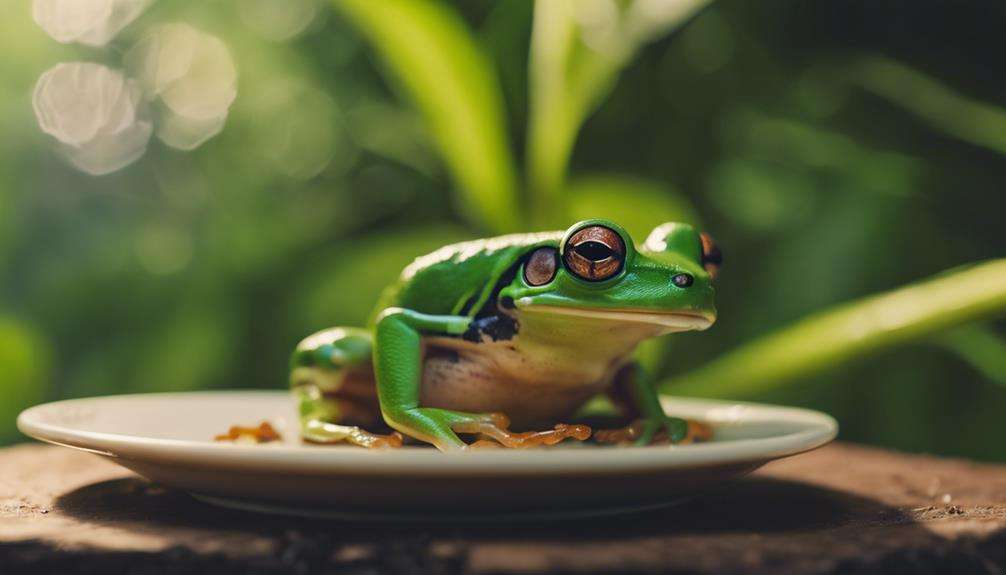
When caring for tree frogs, it's crucial to maintain a proper feeding regimen to ensure their health and well-being. By offering live insects like crickets, mealworms, and waxworms, you provide essential nutrients for their diet.
Adjusting the feeding frequency based on their age and dusting insects with calcium and vitamin supplements are key factors in meeting the nutritional needs of your tree frogs.
Feeding Frequency Tips
Establishing a consistent feeding schedule is crucial for maintaining the health and well-being of your tree frogs.
- Feed juvenile tree frogs daily to support their growth and development.
- Adult tree frogs can be fed every other day to maintain their health.
- Sprinkle the tree frog's food with a calcium supplement daily to ensure proper bone development.
Maintaining a feeding routine for your tree frogs is essential for their overall well-being. Juvenile frogs require daily feeding to aid in their growth, while adult frogs can be fed every other day to sustain their health. Remember to provide a calcium supplement daily to promote bone health and consider a multivitamin supplement weekly for optimal nutrition. Offering a diet comprising gut-loaded crickets and mealworms ensures your tree frogs receive a well-balanced nutritional intake.
Suitable Frog Diets
Establishing a consistent feeding schedule is crucial for maintaining the health and well-being of your tree frogs, ensuring they receive the necessary nutrients for their growth and development.
Tree frogs primarily feed on live insects such as crickets, mealworms, and waxworms. It's essential to dust their prey with calcium and vitamin supplements to provide adequate nutrition.
The feeding frequency should be adjusted according to the frog's age, with juveniles requiring daily meals and adults being fed every other day.
To maintain balanced nutrition, offering a variety of insects is key. Consulting a veterinarian for diet advice is recommended to meet the specific nutritional needs of your tree frogs and ensure their overall well-being.
Feeding Schedule Suggestions
To ensure optimal nutrition for your tree frogs, it's essential to establish a feeding schedule that aligns with their developmental stage and dietary requirements. When considering the feeding schedule for your tree frogs, keep in mind the following suggestions:
- Feed juvenile tree frogs daily to support their growth and development.
- Adult tree frogs can be fed every other day to maintain their health and weight.
- Dust live insects with calcium supplement daily to ensure proper bone health.
Managing Tree Frog Behavior
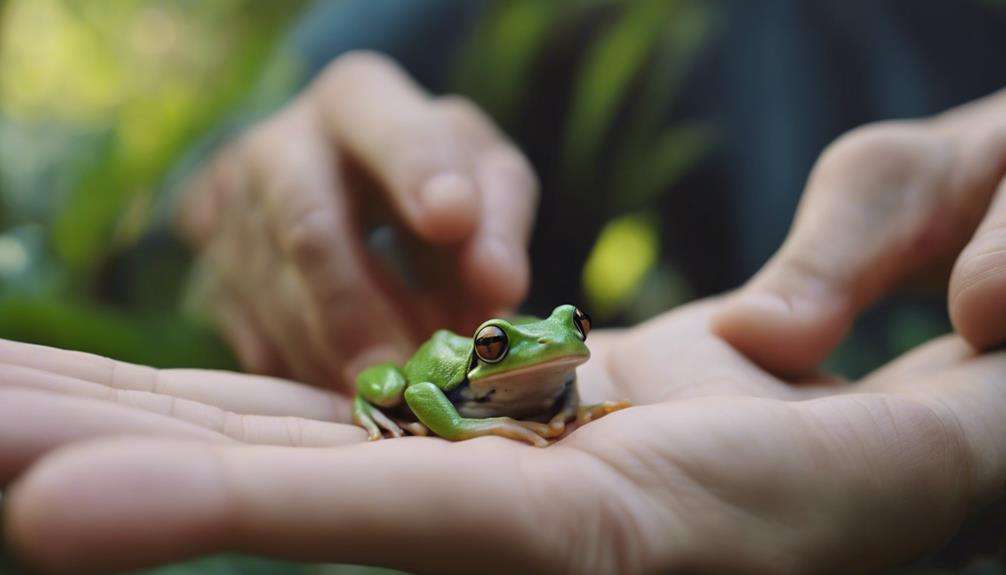
During the night, tree frogs exhibit heightened activity levels due to their nocturnal nature. This behavior is linked to their instinct to climb, making branches and climbing structures essential in their habitat.
The sticky toe pads of tree frogs enable them to effortlessly scale walls and branches. When cohabitating, it's crucial to ensure they're with the same species to prevent any conflicts.
Interestingly, female tree frogs are generally larger than males, allowing for easy sex differentiation. Understanding these aspects of tree frog behavior is vital in managing their habitat effectively.
Maintaining Tree Frog Enclosures
To ensure the well-being of your tree frogs, it's crucial to maintain their enclosures meticulously.
The size of the tank should be a minimum of 10 gallons, providing ample space for the frogs to move around.
Additionally, monitoring and regulating humidity levels and temperature within the enclosure is vital for the health of your tree frogs.
Enclosure Size Requirements
A spacious enclosure of at least 10 gallons is essential for tree frogs to exhibit natural behaviors such as climbing and jumping effectively.
When setting up the enclosure for your tree frogs, consider the following:
- Height Matters: Tree frogs enjoy vertical space, so a tall tank is ideal for them to climb and explore.
- Ventilation is Key: Ensure proper airflow with fiberglass fly-mesh to maintain humidity levels and keep the enclosure well-ventilated.
- Natural Habitat Simulation: Provide foliage, rocks, and branches for your tree frogs to climb, hide, and feel secure in their environment.
Creating an environment that mimics their natural habitat with ample space for movement and climbing will contribute to the well-being of your tree frogs.
Temperature and Humidity Levels
Height matters for tree frogs not only in terms of their enclosure but also plays a crucial role in maintaining optimal temperature and humidity levels essential for their well-being and thriving habitat.
To ensure the best conditions for your tree frogs, maintain a tank temperature between 24-26°C. It's imperative to keep the humidity levels in the enclosure at 50-60% for their optimal health. Utilize thermometers to accurately monitor the temperature within the habitat and hygrometers to measure and regulate the humidity levels.
Create a suitable environment for your tree frogs by incorporating a wet and humid setting, which can be achieved through a water dish or a small pond within their habitat. Monitoring these factors diligently will contribute significantly to the well-being of your tree frogs in their habitat.
Simple Tree Frog Grooming Tips
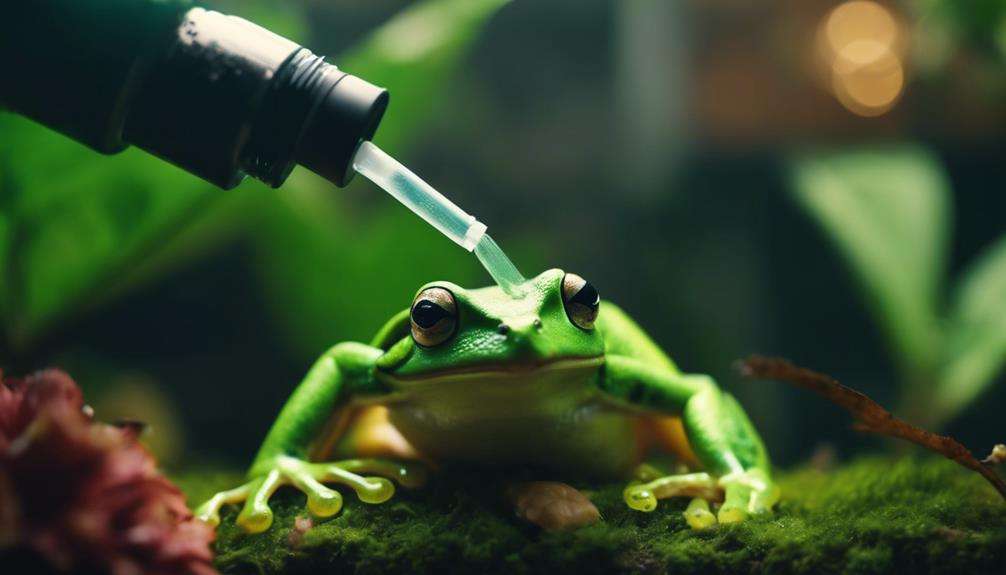
When grooming your tree frog, gently use a soft, damp cloth to wipe its skin and remove any dirt or debris. It's essential to maintain your pet's hygiene to prevent skin issues and ensure its well-being.
Here are some simple tree frog grooming tips to follow:
- Regular Skin Checks: Monitor your tree frog's skin for any signs of shedding or retained shed. Addressing these promptly can prevent complications and discomfort.
- Nail Trimming: Carefully trim your tree frog's nails if they become overgrown. Long nails can lead to injuries or difficulty gripping when climbing.
- Eye Care: Keep an eye on your tree frog's eyes for cloudiness, discharge, or irritation. Any concerning changes may indicate a problem that requires veterinary attention.
Identifying Healthy Tree Frogs
After ensuring proper grooming practices for your tree frog, the next step is to learn how to identify signs of a healthy tree frog. Healthy tree frogs exhibit vibrant coloring, with skins that are smooth and moist. Their eyes are alert and bright, showing no signs of cloudiness.
When looking to purchase a tree frog, opt for captive-bred ones as they're generally healthier and less stressed compared to wild-caught frogs. Captive-bred frogs are also less likely to carry diseases.
To ensure your tree frog remains healthy, regularly check for signs of illness such as dull skin, lethargy, or changes in appetite. These can be indicators of underlying health issues that may need attention.
When handling your tree frog, always remember to do so with care, using gloves to protect their delicate skin from any harmful substances present on your hands. By being attentive to these details, you can help maintain the health and well-being of your tree frog.
Warning Signs in Tree Frog Health
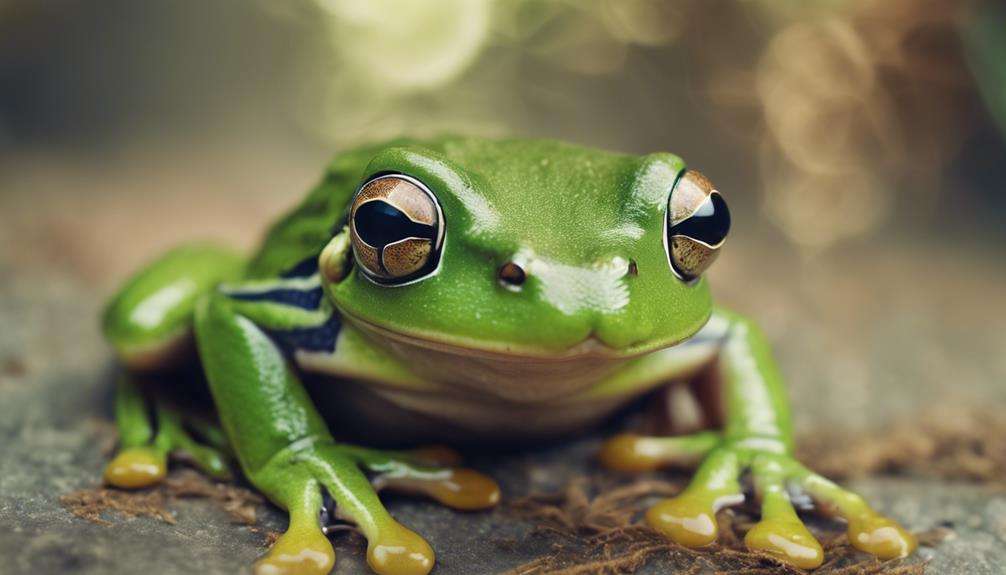
Recognizing warning signs in tree frog health is crucial for proactive care and early intervention in potential health issues. When caring for easy-to-care-for tree frogs, it's essential to stay vigilant for any indicators of underlying problems. Here are some key warning signs to watch out for:
- Skin Changes: Keep an eye out for any changes in your tree frog's skin color, texture, or appearance. These alterations could signal an underlying health issue that needs attention.
- Abnormal Behaviors: Be attentive to any unusual behaviors exhibited by your tree frog, such as excessive scratching, puffing, or abnormal vocalizations. These behaviors may indicate discomfort or illness.
- Weight Loss and Lethargy: If you notice weight loss, decreased appetite, or lethargy in your tree frog, it could be a red flag for health issues. Monitoring your frog's weight and activity levels is crucial for early detection of potential problems.
Common Health Problems in Tree Frogs
Keeping a close eye on the health of your easy-to-care-for tree frogs is essential, as they're prone to common health problems such as skin infections, parasitic infestations, and metabolic bone disease. Skin infections can arise from unhygienic conditions or injuries, leading to redness, swelling, and discomfort for the frogs. Parasitic infestations, like mites or ticks, can weaken the frogs' immune systems and cause skin irritation or internal damage if left untreated. Metabolic bone disease can occur due to calcium or vitamin D deficiencies, resulting in weakened bones and deformities.
Respiratory infections, including pneumonia, may develop in tree frogs exposed to stress, poor air quality, or incorrect temperature levels in their habitat. Obesity and malnutrition are often linked to improper diet choices and feeding practices, impacting the overall health and longevity of tree frogs. Additionally, external injuries from rough handling or sharp objects can lead to infections if not promptly addressed. Overheating, due to inadequate temperature regulation, can cause heat stress and other health complications in tree frogs. Regular monitoring and proper care can help prevent and address these common health issues in tree frogs.
Essential Supplies for Tree Frog Care
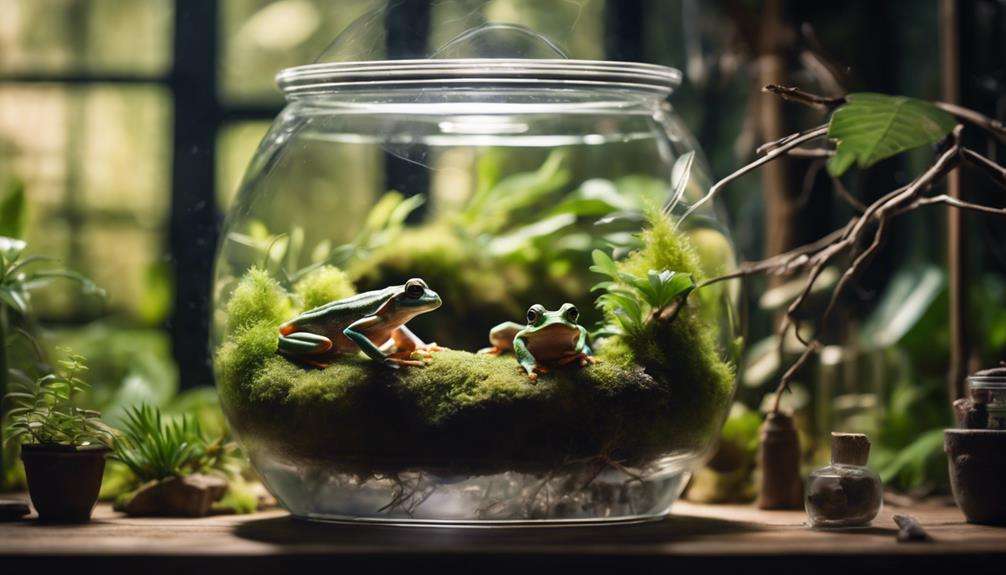
To properly care for your tree frogs, you must ensure they have a 10-gallon tank with appropriate substrate, foliage, rocks, and branches for climbing.
Maintain the tank temperature at 24-26°C and humidity levels between 50-60% for their well-being.
Use thermometers and hygrometers to accurately monitor these crucial environmental conditions.
Housing Requirements
For proper housing of tree frogs, it's essential to provide a tank of at least 10 gallons, tall and waterproof, along with suitable substrate and climbing materials mimicking their natural habitat.
When setting up the enclosure, consider using fiberglass fly-mesh enclosures with coconut fiber or bark bedding as substrate. Introduce foliage, rocks, and branches for climbing accessories to create a habitat that resembles their natural surroundings.
To ensure the optimal health of your tree frogs, maintain the tank temperature between 24-26°C and humidity levels at 50-60%. Use thermometers to monitor temperature fluctuations and hygrometers to track humidity levels accurately.
These measures will help create a comfortable and safe environment for your tree frogs.
Feeding and Nutrition
Ensuring proper nutrition for tree frogs is essential to support their carnivorous dietary needs for optimal health and vitality. Feed your tree frogs a diet of live insects such as crickets, mealworms, and waxworms to meet their carnivorous requirements. Dusting the insects with a calcium supplement daily and providing a multivitamin supplement once or twice a week ensures balanced nutrition.
Adjust the feeding frequency based on the age of your tree frog, offering daily meals for juveniles and feeding adults every other day. Keep fresh, clean, chlorine-free water available at all times for hydration. To promote overall health, offer a variety of insects to create a well-balanced diet that supports the vitality of your tree frog.
Frequently Asked Questions
What Are the Easiest Tree Frogs to Keep?
For those new to tree frog care, green tree frogs are the easiest species to keep. Their simple care routine includes creating an ideal habitat, feeding them live insects, maintaining proper temperature and humidity levels, and regular tank cleaning.
Is It Easy to Take Care of a Tree Frog?
Taking care of a tree frog is straightforward. Maintain humidity levels at 50-80%, temperature between 75-85°F, feed them live insects, provide climbing spaces, hideouts, and suitable lighting. Keep their habitat clean, watch for common diseases, and enjoy observing their unique behavior.
What Do Tree Frogs Need in Their Tank?
In your tree frog's tank, ensure proper lighting, a feeding schedule, and ideal humidity. Decorate with foliage, rocks, and branches. Maintain temperatures at 24-26°C. Keep a water source for hydration. Regularly clean for their health.
Are Tree Frogs Easy Pets?
Keeping tree frogs as pets is a breeze due to their low maintenance requirements. They thrive with a well-set habitat, regular feeding of live insects, minimal handling, and proper temperature control. Observing their behavior enriches your experience.
Conclusion
You have learned about the best colorful tree frogs for beginners, suitable habitats, easy feeding regimen, behavior management, enclosure maintenance, and identifying healthy frogs.
Remember to watch out for warning signs in frog health and common health problems. Ensure you have essential supplies for proper care.
By following these guidelines, you can enjoy a rewarding experience caring for easy-to-care-for tree frogs in your home. Happy frog-keeping!
